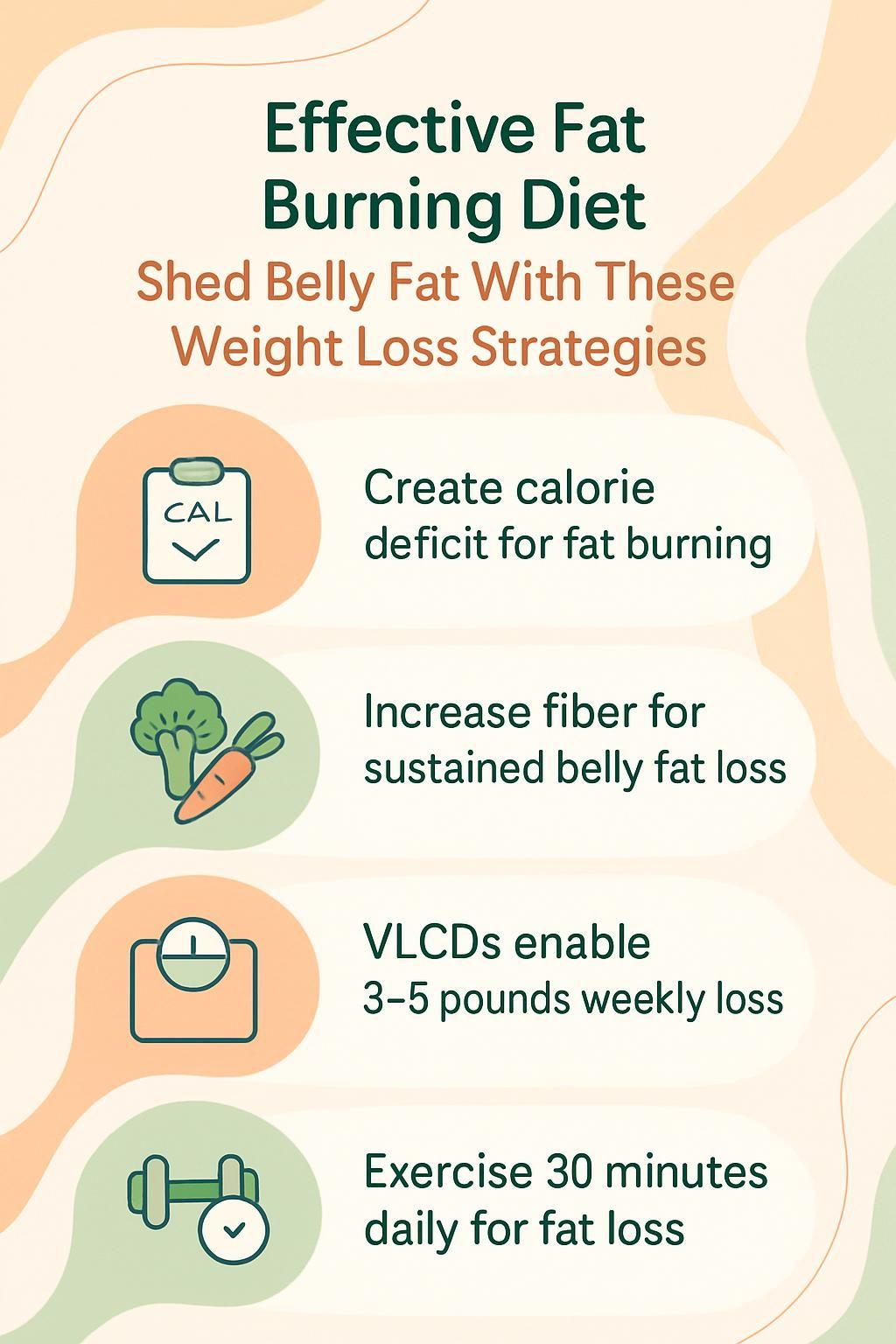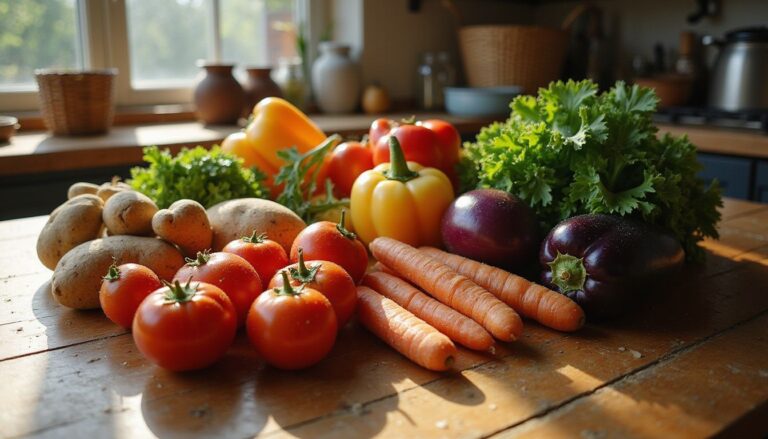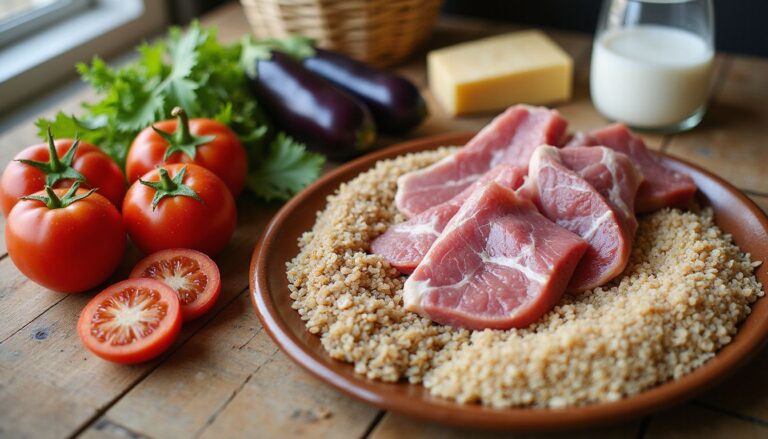Effective Fat Burning Diet: Shed Belly Fat With These Weight Loss Strategies
Our Nutrition Assistant AI Suite will transform your body. You will lose fat, get toned, and build muscle. Gain confidence and optimal health.
Struggling with belly fat is common, especially if weight loss has stalled. A smart diet creates a calorie deficit, which means you burn more energy than you eat. That is the core of fat loss.
In this guide, you will learn proven diet strategies, see which fat-fighting foods help most, and get simple steps you can use today. From Greek yogurt to green tea, these choices support a healthier life and a slimmer waist.
Keep reading to learn how to build habits that deliver steady, lasting results.
Key Takeaways
- A fat-burning diet centers on a calorie deficit and nutrient-dense foods, such as lean protein, vegetables, whole grains, and healthy fats. Guidance aligns with the Academy of Nutrition and Dietetics and the Mayo Clinic Diet.
- Eating more dietary fiber from beans, quinoa, and berries supports fullness, steadier blood sugar, and gradual belly fat loss, as noted by the American Diabetes Association.
- Very low-calorie diets, about 800 calories per day, can produce 3 to 5 pounds of loss per week but require medical supervision, according to DeGroot’s Endocrinology, 2023.
- Daily aerobic exercise, at least 30 minutes, plus resistance training preserves muscle, improves metabolism, and speeds fat loss, supported by the U.S. Preventive Services Task Force and the American Cancer Society.
- Avoid trans fats and sugary drinks to cut abdominal fat and lower risks for heart disease, consistent with FDA guidance and the 2020-2025 Dietary Guidelines for Americans.

What is a fat-burning diet and how does it work?

A fat-burning diet helps your body tap into stored fat for fuel. The plan uses a calorie deficit, which means eating fewer calories than you burn each day. You focus on nutrient-dense foods with high quality protein, fiber, and healthy fats.
Core foods include lean meats, fish, Greek yogurt, tofu, beans, non-starchy vegetables, fruits, and whole grains. Fiber from beans and vegetables supports fullness and steadier blood sugar. That makes it easier to stick with your eating plan and lose belly fat without constant hunger.
Protein from chicken, fish, eggs, or yogurt helps preserve muscle during weight loss. Keeping muscle supports your metabolism, so more of the weight you lose comes from fat. Limiting added sugar, refined grains, and highly processed foods also lowers risk for heart disease and type 2 diabetes.
My own routine was simple. I swapped soda for water, drank green tea in the morning, and kept berries and crunchy vegetables on hand for snacks. Energy improved and the plan felt easier to follow.
Key principles of a fat-burning diet
These principles give your plan structure. Small, steady steps build momentum and help you lose stubborn belly fat.
How can eating fewer calories than you burn help you lose fat?
A calorie deficit forces your body to use stored fat for energy. This is the engine of fat loss. Every effective weight loss diet follows this rule.
Very low-calorie diets, about 800 calories per day, can cause rapid loss. Low-calorie plans often range from 1,200 to 1,500 calories per day for women and 1,500 to 1,800 for men. Fast results can slow metabolism if the plan is too strict or too short. Many people regain weight after extreme dieting, so medical guidance is essential for very low intakes.
Why should you prioritize protein-rich foods?
Protein boosts fullness and costs more energy to digest than carbs or fat. That means higher calorie burn at each meal. It also protects muscle, which is critical for a healthy metabolism during a weight loss diet.
Eggs provide about 7 grams of protein for only 75 calories. Greek yogurt supplies nearly twice the protein of regular yogurt. Lean cuts of beef and skinless chicken give protein with less saturated fat. Fish offers protein and omega-3s for heart and metabolic health. Plant options such as quinoa add protein plus fiber for extra satiety.
“A higher intake of dietary protein increases fullness and may promote weight loss by boosting calorie burning.”
Skim milk gives protein without the extra fat in whole milk. Thoughtful protein choices make it easier to stay on track and reduce abdominal fat.
What are healthy fats and why include them?
Your body needs healthy fats for hormone function, appetite control, and heart health. Choose unsaturated fats from olive oil, avocado, nuts, seeds, and fish. These fats make meals more satisfying, which can help you eat fewer calories overall.
Fatty fish like salmon and herring supply omega-3 fatty acids that support cardiovascular health. Nuts and seeds deliver healthy fats, protein, and fiber, though portions should be modest because they are calorie dense. Swapping creamy dressings for olive oil and vinegar cut my calories without losing flavor.
Favor unsaturated fats and avoid trans fats in processed snacks. This supports weight loss and long-term heart health.
How does increasing fiber intake aid fat burning?
Fiber slows digestion and increases fullness. Soluble fiber, found in beans, oats, apples, and grapefruit, absorbs water and helps you feel satisfied on fewer calories. One cup of beans gives about 12.5 grams of fiber for a strong appetite buffer.
Whole grains such as quinoa and bulgur add fiber and plant nutrients. A cup of cooked quinoa provides around 5 grams of fiber. Choosing fiber-rich foods steadies blood sugar, lowers the urge to snack, and supports sustainable fat loss.
Why is staying hydrated important for weight loss?
Hydration supports energy, digestion, and temperature control. When you cut calories, dehydration can slow metabolism and increase fatigue. Drinking enough water helps control appetite and improves workout performance.
High water foods like watermelon and broth-based soups fill you up with few calories. A salad loaded with watery vegetables before dinner can reduce total intake. Green tea hydrates and supplies catechins that can raise fat burning slightly. Black coffee can help too if you skip the sugar and cream.
Fat-burning foods that help reduce belly fat
Targeted foods work like helpful tools. Use them often and they can make the rest of your plan easier.
How does Greek yogurt support fat loss?
Greek yogurt is rich in protein, which increases satiety and helps protect muscle. Choose nonfat or low-fat and low-sugar versions to keep calories in check. Dairy protein supports muscle during weight loss, so more fat, not muscle, is lost.
I like Greek yogurt with berries or a small sprinkle of nuts for crunch. Skim milk and other low-fat dairy can round out your protein intake while keeping calories moderate.
What makes quinoa a good fat-burning food?
Quinoa offers protein and fiber in one grain. Each cooked cup has about 8 grams of protein and 5 grams of fiber. That combination supports fullness, steadier blood sugar, and better weight management.
It also contains iron, zinc, selenium, and vitamin E. Use quinoa in salads or as a side. Whole grains like quinoa are encouraged by the Academy of Nutrition and Dietetics for long-term weight control.
Can hot peppers boost your metabolism?
Hot peppers contain capsaicin, the compound that gives peppers their heat. Capsaicin can increase calorie burn for a short period and may reduce appetite for some people. A 2023 review found modest effects on metabolism.
Add diced peppers to eggs, salads, or stir-fries for flavor and a small boost. The effect is mild, so it should support, not replace, your diet and exercise plan.
What are the benefits of drinking green tea for fat loss?
Green tea contains catechins, antioxidants that can raise fat oxidation and support weight maintenance. Research in the American Journal of Clinical Nutrition links daily green tea, as part of a calorie-reduced diet, with improved fat loss.
Several cups per day without sugar or cream add hydration with almost no calories. I replaced sweet drinks with green tea and found it easier to stay within my calorie target.
How does grapefruit contribute to fat burning?
Grapefruit is high in soluble fiber and water. That combination increases fullness and may lead to lower calorie intake at meals. Some research suggests eating half a grapefruit or drinking its juice before meals can reduce total calories eaten.
Eat the whole fruit to get more fiber. If you take certain medicines, ask your clinician first since grapefruit can interact with some drugs.
Why are berries effective for weight loss?
Berries have lots of fiber and water, so they fill you up with few calories. Blueberries, strawberries, raspberries, and blackberries often contain under 60 calories per cup. Fiber helps stabilize blood sugar and curb overeating.
They also supply vitamins and plant compounds that support heart health. Choose whole berries instead of juice to get the full fiber benefit.
How do raw vegetables aid in fat burning?
Raw vegetables are low in calories and high in water and fiber. For example, a half cup of diced celery has about 8 calories. Eating raw veggies before meals can reduce intake of higher-calorie foods.
I started packing carrot sticks and cucumber slices for work. Cravings dropped and it was easier to stick to my plan. Rotate your choices for variety, such as broccoli florets one day and leafy greens the next.
What lean meats and fish help reduce fat?
Skinless chicken breast, flank steak, eye of round, and top sirloin are solid lean choices. Fish like cod, tilapia, and haddock are low in fat and high in protein. Salmon and herring provide omega-3 fats that support heart health and metabolism.
Grilling or baking instead of frying keeps calories lower. Protein increases satiety and helps protect muscle, which supports steady fat loss.
How do nuts and seeds support weight loss?
Nuts and seeds offer healthy fats, protein, and fiber. Almonds, walnuts, chia, and flax can help you feel full longer and support heart health. Portion control matters because these foods are calorie dense.
Add a small handful to yogurt or salads for crunch and staying power. Research shows moderate nut intake is linked with less belly fat over time.
Effective strategies to shed belly fat
Practical steps beat perfect plans. Pick a few, apply them well, and build from there.
How does eating soluble fiber help lose belly fat?
Soluble fiber thickens in the gut and slows digestion. Foods like grapefruit, beans, pears, and apples with the peel increase fullness and reduce total calories eaten. Oatmeal and bulgur also steady blood sugar and appetite.
Experts from the American Diabetes Association and the Academy of Nutrition and Dietetics connect higher fiber intake with less visceral fat. I raised my oatmeal and apple intake and noticed fewer cravings through the afternoon.
Why should you avoid trans fats?
Trans fats raise heart disease risk and tend to increase belly fat. The FDA no longer recognizes them as safe. They are found in some baked goods, fried items, and certain margarines.
Replace trans fats with unsaturated fats from nuts, olive oil, and avocado. This switch supports healthier cholesterol and better weight control.
How does limiting sugary foods and drinks affect belly fat?
Sugary drinks spike blood sugar and insulin, which can increase abdominal fat. The 2020-2025 Dietary Guidelines for Americans advise limiting added sugars. Soda and many fruit juices lack fiber, so they do not keep you full.
Swap sweet beverages for water or unsweetened tea. I moved from sweetened drinks to water and noticed fewer energy crashes and late-night cravings.
What is the role of increased protein intake in fat loss?
Higher protein intake increases fullness and raises the calories burned during digestion. Eggs, lean meats, fish, skim milk, and Greek yogurt are strong options with a good protein to calorie ratio.
Protein also helps preserve muscle. Because muscle burns more calories than fat at rest, keeping muscle supports continued fat loss.
How does reducing refined carbs help shed belly fat?
Refined carbs like white bread, regular pasta, and sugary cereals digest quickly. They can trigger hunger soon after meals. Whole grains such as quinoa, rye crispbreads, and bulgur deliver more fiber and nutrients.
People who replace refined grains with whole grains often see less abdominal fat. I swapped white bread for whole grain crispbreads and felt more satisfied between meals.
Why is aerobic exercise important for fat burning?
Aerobic exercise helps you burn calories and reduces visceral belly fat. Brisk walking, cycling, jogging, and swimming also strengthen the heart and lungs. Many guidelines suggest at least 30 minutes daily for health and weight loss.
Combining cardio with a balanced diet improves results and reduces the risk of type 2 diabetes and sleep apnea.
How does resistance training contribute to fat loss?
Resistance training preserves and builds muscle while you lose weight. More muscle raises your resting metabolism. This helps your body burn more calories all day.
Pair strength work with protein-rich meals to protect lean tissue. Studies show combining resistance training with aerobic exercise improves fat loss more than either alone.
What is intermittent fasting and how does it help with belly fat?
Intermittent fasting alternates periods of eating and fasting. Common methods include 16:8 time-restricted eating or the 5:2 approach. These patterns can lower calorie intake, improve insulin sensitivity, and support fat use for fuel.
Rapid weight loss methods need medical guidance. Intermittent fasting is not ideal for everyone, including children, teens, pregnant women, and some older adults. Ask your clinician before starting.
Types of fat-burning diets explained
Different plans use different levers. The right fit is the one you can sustain.
What is a Very Low-Calorie Diet (VLCD)?
A VLCD limits intake to about 800 calories per day using medically supervised meal replacements. It is used for adults with obesity who need rapid loss, often before surgery. People may lose 3 to 5 pounds weekly.
Strict supervision is required, and most people should not follow a VLCD longer than 12 weeks. Rapid loss is often followed by regain if support ends. Regular check-ins help monitor health and guide a safe return to normal meals.
How does a low-carbohydrate diet work for fat loss?
A low-carb diet reduces foods rich in refined grains and sugar. Meals emphasize lean protein, low-starch vegetables, some whole grains, and healthy fats from nuts and seeds. With fewer carbs, your body relies more on stored fat for energy.
Research, including meta-analyses of trials, supports low-carb approaches for weight and blood sugar control. Make sure to include enough fiber and protein for balance. Talk with your clinician if you have health conditions or take medications.
What are the benefits of a high-protein diet?
High-protein diets increase fullness, raise calorie burn during digestion, and help protect muscle. Lean meats, fish, eggs, beans, and quinoa are practical choices. Higher protein intake is linked with lower belly fat and better weight maintenance.
During my own effort to trim my waist, I chose eggs at breakfast and lean chicken at lunch. Staying satisfied made it easier to manage portions.
How does the Mediterranean diet promote fat burning?
The Mediterranean diet highlights vegetables, fruits, legumes, whole grains, olive oil, fish, and nuts. Fiber-rich foods keep you full, and healthy fats support heart and metabolic health. Lean protein from seafood and poultry helps maintain muscle during weight loss.
Spices and green tea can help with appetite and blood sugar control. Limiting processed foods supports better cholesterol and blood pressure.
What is the ketogenic diet and how does it burn fat?
The ketogenic diet is very low in carbohydrates, moderate in protein, and high in fat. After a few days with very little carbohydrate, the body enters ketosis. In ketosis, your liver turns fat into ketones, which your body uses for energy.
This shift can speed fat loss for some people. Typical foods include eggs, fish, olive oil, cheese, nuts, and avocado. The diet is strict, so consider medical guidance if you have any conditions.
How does exercise aid in fat loss?
Movement acts like a multiplier. It helps your diet work better and supports long-term weight management.
What are cardio workouts and their benefits for fat loss?
- Cardio like running, cycling, and swimming burns many calories, which helps create a calorie deficit.
- Aerobic training strengthens the heart and lungs, easing strain on your body.
- High-Intensity Interval Training, or HIIT, can raise your metabolic rate for hours after a workout.
- Combining cardio with strength training builds muscle, which increases calories burned at rest.
- Cardio improves insulin sensitivity and can prevent excess belly fat gain.
- Activities such as brisk walking can reduce stress hormones that interfere with fat loss.
- Regular cardio lowers dangerous abdominal fat tied to heart disease and type 2 diabetes.
- Steady cardio routines can help regulate appetite, making it easier to follow your diet.
Include cardio several days per week to increase the impact of your weight loss diet.
How does strength training help reduce fat?
Strength training increases muscle mass, which boosts resting metabolism and post-workout calorie burn. It also helps create a calorie deficit and preserves lean tissue while you lose weight. Better insulin sensitivity is another plus, which supports steady fat loss.
From my own routine of lifting three days a week, I noticed a smaller waist and more energy. Pair this training with protein-rich meals for best results.
Summary Table:
| Benefit | Supporting Fact |
|---|---|
| Increased metabolism | Muscle burns more calories at rest |
| Higher calorie deficit | Burns calories during and after workouts |
| Lean muscle preservation | Protects muscle during weight loss |
| Better insulin control | Supports steady fat loss |
What is High-Intensity Interval Training (HIIT) and why is it effective?
HIIT alternates short bursts of hard effort with brief recovery. This raises calorie burn during the workout and for hours afterward, often called the afterburn effect. HIIT can improve insulin sensitivity and reduce body fat more quickly than steady-state cardio for many people.
Short, focused sessions paired with a protein and fiber rich diet can bring visible progress in weeks.
Additional tips for long-term fat loss success
Habits carry you when motivation fades. Build a routine you can repeat on busy days.
Why is getting adequate sleep important for weight loss?
Sleep helps regulate ghrelin and leptin, hormones that control hunger and fullness. Poor sleep raises hunger and cravings for calorie-dense foods. It can also slow metabolism and reduce recovery from workouts.
Set a regular bedtime and wind down with a calm routine. Good sleep, smart meals, and regular activity work together.
How does managing stress levels affect fat burning?
Chronic stress raises cortisol, which is linked to belly fat and stronger junk food cravings. Simple tactics can help, such as paced breathing, short walks, or a quick stretch break.
Exercise lowers stress and boosts calorie burn. Good nutrition and solid sleep help keep hormones stable so your plan stays on track.
How can tracking your food intake improve fat loss?
Food tracking shows what and how much you are eating. Patterns become clear, and small changes are easier to make. Research shows people who track tend to lose more weight.
I used a tracking app for three months, and it kept portions honest. The log also revealed meals that lacked protein or fiber.
Why should you avoid processed foods?
Highly processed items often pack added sugar, unhealthy fats, and lots of sodium. These foods can drive hunger and raise long-term health risks. Whole foods provide more nutrients and fiber, which help with fullness and stable energy.
Choosing whole options helped my blood sugar feel steadier and reduced late-day snacking.
How to adopt sustainable lifestyle changes for lasting results?
Keep adjustments small and repeatable. Eat more high-fiber foods and whole grains for fullness. Choose protein at each meal to protect muscle and manage appetite.
Commit to at least 30 minutes of daily movement, such as brisk walking or strength work. Aim for one to two pounds lost per week. If you have medical conditions, talk with your healthcare provider before major changes.
What are the potential health benefits of fat-burning diets?
Beyond a smaller waist, these habits support better health across many systems.
How does reducing abdominal fat improve health?
Less abdominal fat lowers risk for type 2 diabetes and heart disease. More fiber improves fullness and blood sugar control. Lean protein supports muscle and steady energy while you cut calories.
Staying hydrated also helps with appetite control and digestion. With balanced meals and regular activity, many people notice steadier energy and improved focus.
What heart health benefits come from fat-burning diets?
Fat-burning diets reduce belly fat and support healthier cholesterol and blood pressure. High-fiber foods and whole grains help control hunger and replace less healthy snacks. Nuts and fish add omega-3 fats that support heart health.
Green tea and spices such as cinnamon may help with blood sugar control, which reduces strain on the heart. Combined with regular physical activity, these habits lower the risk of heart attack and stroke.
How can these diets lower the risk of type 2 diabetes?
Better weight management reduces insulin resistance, a major driver of type 2 diabetes. Protein-rich foods like Greek yogurt support fullness and steady intake. Whole grains and vegetables add fiber that smooths blood sugar swings.
Daily activity boosts insulin sensitivity. After increasing my fiber intake, my energy felt more stable across the day.
In what ways do fat-burning diets enhance metabolism?
Protein raises the calories you burn while digesting a meal. Fiber supports fullness, gut health, and steadier eating patterns. Spices like capsaicin and cinnamon, and drinks like green tea, can cause small increases in calorie use.
Choosing unprocessed foods limits added sugars and unhealthy fats, which supports better metabolic health over time.
Conclusion
An effective fat-burning diet focuses on a calorie deficit, protein, fiber, healthy fats, and hydration. Simple swaps, like Greek yogurt for snacks and whole foods over processed foods, add up. Pair these choices with regular cardio and strength training for steady weight loss.
Progress comes from daily actions you can repeat. Start with one or two steps this week. If you have medical concerns, consult a qualified professional before making major changes. Steady effort brings a leaner waist, better health, and more confidence.
FAQs
1. What foods should I eat in an effective fat burning diet to reduce belly fat?
Choose foods high in protein, fiber, and healthy fats. Examples include lean poultry, fish, eggs, beans, lentils, nuts, seeds, leafy greens, and whole grains. Studies show that diets rich in these foods help control hunger and support weight loss.
2. How many calories should I consume daily for weight loss?
A daily calorie deficit of 500 to 1,000 calories can help most people lose about 1 to 2 pounds per week. For many adults, this means eating between 1,200 and 1,800 calories per day, depending on age, gender, and activity level. The National Institutes of Health recommends tracking food intake for accuracy.
3. Does exercise help with belly fat loss when following a fat burning diet?
Regular physical activity increases calorie burn and helps preserve muscle during weight loss. Aerobic activities like brisk walking or cycling combined with strength training can improve results. Research from Harvard University found that combining diet with exercise leads to greater fat loss than diet alone.
4. Can I keep the weight off after losing belly fat with these strategies?
Long-term success depends on maintaining healthy eating habits and regular exercise. A personal example: After switching to a high-protein diet and walking daily, I lost 15 pounds over six months and kept the weight off by planning meals and staying active. Consistent habits support lasting results.
Summary: An effective fat burning diet includes protein-rich foods, fiber, and healthy fats while maintaining a calorie deficit. Combining these strategies with regular exercise improves fat loss and helps keep weight off over time. Reliable sources support these methods as safe and effective for most adults.







